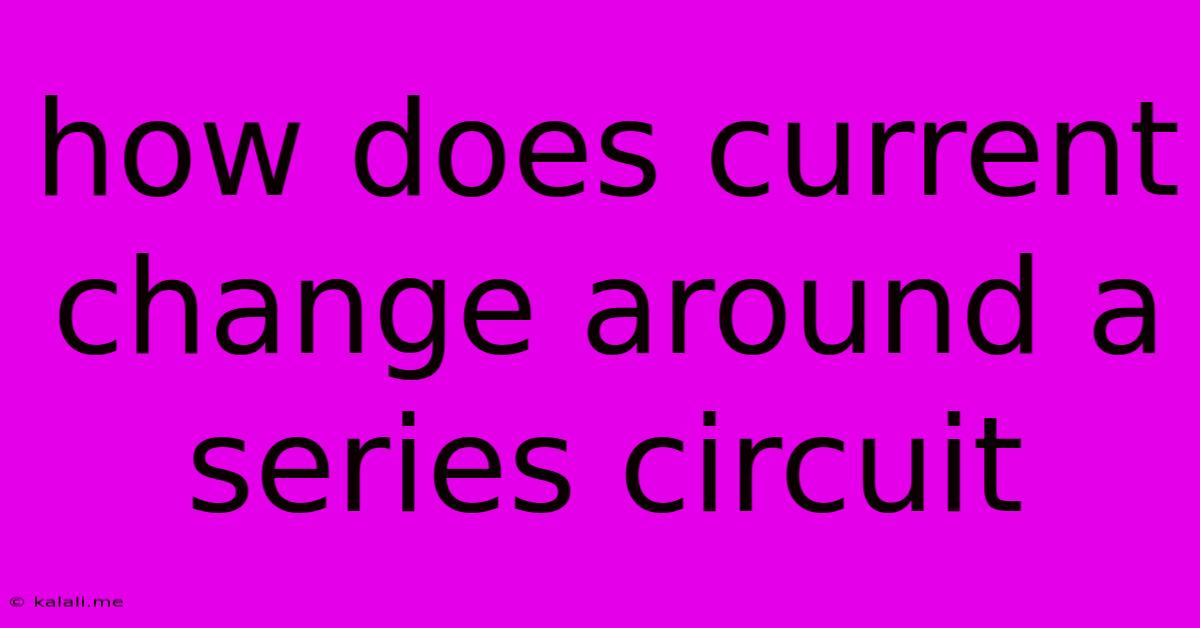How Does Current Change Around A Series Circuit
Kalali
May 22, 2025 · 3 min read

Table of Contents
How Does Current Change Around a Series Circuit?
Understanding how current behaves in a series circuit is fundamental to grasping basic electricity. This article will explain the key principles governing current flow in series circuits, answering the question: how does current change (or rather, doesn't change) around a series circuit? It's a simple concept with important implications for circuit design and troubleshooting.
The Series Circuit: A Single Pathway
In a series circuit, all components are connected end-to-end, forming a single, continuous loop for the current to flow through. Imagine a single road with several houses along it – the electricity, like cars, has only one route to take. This contrasts with a parallel circuit, where components are connected across multiple paths.
Unlike parallel circuits, the current in a series circuit remains constant throughout. This means the same amount of electrical charge flows through each component, regardless of its resistance or type. This consistency is the defining characteristic of current flow in a series configuration.
The Unchanging Nature of Current in a Series Circuit
The reason for the unchanging current is based on the principle of conservation of charge. In a closed circuit, the electric charge doesn't disappear or get created; it simply flows around the circuit. Since there's only one path, the same amount of charge that enters a component must also exit it. This necessitates a constant current throughout.
Consider a simple series circuit with a battery and two resistors. The current flowing from the positive terminal of the battery will travel through the first resistor, then the second resistor, and finally back to the negative terminal of the battery. The current's magnitude is the same at every point in the circuit; it doesn't increase or decrease.
Implications of Constant Current
This constant current has several implications for circuit design and analysis:
-
Voltage Division: While the current remains constant, the voltage across each component varies depending on its resistance (Ohm's Law: V = IR). Higher resistance components will have a larger voltage drop across them.
-
Troubleshooting: A break in any part of a series circuit will interrupt the entire circuit, resulting in a complete current stoppage. This makes troubleshooting relatively straightforward; finding the broken component is usually simple.
-
Series Resistors: Adding resistors in series increases the total resistance of the circuit, reducing the overall current. This is because the total resistance is simply the sum of individual resistances.
-
Practical Applications: Series circuits are commonly used in various applications, including simple lighting circuits, where each light bulb experiences the same current.
Understanding Ohm's Law in Series Circuits
Ohm's Law (V = IR) is crucial for analyzing series circuits. While the current (I) remains constant, the voltage (V) across each component depends on its individual resistance (R). The total voltage supplied by the source is equal to the sum of the voltage drops across each component in the circuit.
In Summary: The Consistent Current Flow
In conclusion, the current in a series circuit remains constant throughout the entire loop. This fundamental characteristic stems from the conservation of charge and has significant implications for circuit design, analysis, and troubleshooting. Understanding this principle is essential for anyone working with electrical circuits, from hobbyists to professional engineers.
Latest Posts
Latest Posts
-
When Does One Piece Animation Change
May 22, 2025
-
Can You Make Dua On Your Period
May 22, 2025
-
Whats The Difference Between A Bar And A Pub
May 22, 2025
-
Can You Use Xbox 1 Controller On Xbox 360
May 22, 2025
-
Wire A 2 Gang Light Switch
May 22, 2025
Related Post
Thank you for visiting our website which covers about How Does Current Change Around A Series Circuit . We hope the information provided has been useful to you. Feel free to contact us if you have any questions or need further assistance. See you next time and don't miss to bookmark.